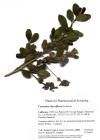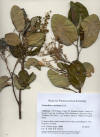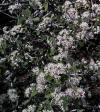of adjacent montane
chaparral in Kern County..............................................Ceanothus cuneatus
4.
Undersurface of leaves with white flecks (hair patches over stomata crypts)
aligned along mid and lateral veins;
infl.
exceeding leaves, leaf margins
not sharply differentiated, often appearing
irregularly toothed, pedicels
relatively thin,
flexuous; fruit shiny red, smooth, or
with short projections
appearing like pimples, spikes, or flattened warts at right angles near
base; mostly montane chaparral on
western and northern slopes above
ghost pine-oak and juniper woodlands in
the Piute Mts. region, in
pinyon pine woodlands with manzanita and/or juniper on east and
southern slopes bordering the Mojave Desert,
and in montane chaparral
on northern slopes in the Transverse Ranges
and in evergreen oak and
juniper woodlands along the eastern Sierra Nevada.... Ceanothus cf. vestitus
4.
Leaf venation or hair patches not clearly evident on undersurface,
± uniformly downy pubescent (leaves usually narrowly elliptical,
similar to C. pauciflorus except for the
inconspicuous stipules;
woodlands in Kern River Canyon and upper montane chaparral in
the Piute Mts and Sierra Nevada................................
Ceanothus × cuneatus
5.
Persistent stipules conical—long tapered to tip, 1–2x the length of
petiole, 3× longer than wide; mainland Mexico...........
Ceanothus pauciflorus
5.
Persistent stipules short conical to mound-like, ± equal to or longer
than
petiole..................................................................................................... 6
6.
Leaves wedge-shaped to elliptic, >1.5× longer than wide, thickened
lip-like along margins; leaf undersurface areolate reticulate,
similar to
C. cuneatus except for the incomplete tertiary veins,
the young
leaves often uniformly white canescent; infl.
relatively short, less to
equal leaf length, pedicels relatively
thin and flexuous; southwestern
desert mountains but not in California................................
Ceanothus greggii
6.
Leaves broad elliptic to ± round in outline, 1–1.5× longer than wide,
toothed and/or tightly revolute along margins; leaf undersurface
with prominent pinnate venation;
infl. exceeding leaves................................. 7
7.
Low shrubs broader than high, mound to mat-like....... Ceanothus
pinetorum
7. Medium
to large shrubs, usually taller than
wide............................................ 8
8. Leaves plane to
upcurved, toothed, slightly contorted along margins,
truncated and/or with a terminal broad triangular tooth
tapering to
a sharply pointed apex; stipules conspicuous on twigs after
leaves
have fallen, longer than wide, often aging black, cone-like tip
± curved and pointed
.............................................. Ceanothus
perplexans
8. Leaves wrinkled
when dried, plain or tightly curled (revolute) along
wavy toothed margins to below mid region, ± white underneath,
reticulate veins ± obscured by white hairs (var. crassifolius),
or
white areolate (var. planus); stipules not usually persistent on
leafless
portions of twigs, nearly round to short conical, often wider than high,
remainng red orange, cone-like tip ± straight, with a blunt or rounded
tip ....................... ...........
.......... Ceanothus crassifolius
9. Spiny
...............................................................................
10
9.
Not spiny
...............................................................................
11
10.
Shrubs wider than tall, <1.5 m high, conifer forest
region
............................................... Ceanothus
cordulatus
10.
Shrubs taller than wide, often 2–4 m high; foothill and montane
woodlands
............................................. Ceanothus
leucodermis
11.
Leaves evergreen with glandular teeth along
margins................................. 12
11.
Leaves deciduous or semi-deciduous, margins entire or denticulate
at apex
................................................................................
14
12.
Erect shrubs; leaves 3-veined at base...........................
Ceanothus oliganthus
12.
Low round or matted shrubs; leaves pinnately veined from
base................ 13
13.
Growing as mats not more than 30 cm high; draws, flats, road banks, oak |
pine wd or forest, 900–1800 m, Klamath, Cascades, Sierra Nevada;
May–Jun
............................................ Ceanothus
diversifolius
13.
Plants not as low to the ground, 30–80 cm high; open wooded slopes
and road banks of ponderosa pine cedar fir and Doug fir forests,
1200–3500 ft, N. Coast Ranges; Klamath Mts; foothills of Cascade
Range & Sierra Nevada, Apr–May.................................
Ceanothus lemmonii
14.
Leaf blades oval in outline, tapering from near base, 2.5–7 cm
long; lateral veins 3–4 pairs, 3-veined at base; petioles
6–12 mm long
............................................ Ceanothus
integerrimus
14.
Leaf blades partly elliptic, the margins ± parallel in mid region
before tapering to apex, 0.6–3.5 cm long; lateral veins 6 pairs,
not 3-veined except seedlings and stump sprouts;
petioles 2–5 mm long
................................................... Ceanothus
palmeri
Ceanothus cordulatus
Kellogg 1861. Mountain white thorn, Snow bush. Low
intricately branched shrub with many short zigzag spiny branches along
main stems, wider than tall with a broad flat crown, to 50 cm high and
several m or more broad; bark whitish-gray; branches alternate, ending
in sharp spines; leaves alternate, thin, 3-veined at base, round or
broad elliptical, 1–2× longer than wide, 1–2.5 cm long, slightly folded
or curved upwards along the midrib, entire or nearly so; flowers
May–Jul, white, fragrant, on long pedicels1.5–3 cm in umbellate
fascicles arising from short thorny branches with or without leaves;
fruit Jul–Aug. Montane conifer forest above 4,000 ft; southern Oregon to
the San Pedro Mártir in Baja California except South Coast Ranges, and
to the Spring Mts. in southwestern Nevada. Type from near Washoe, NV.
“Mountain white thorn chaparral” (alliance) recognized in MCV2 when >50%
relative cover in the shrub canopy. Kern Co.: “Common in the high
mountains, mostly in exposed rocky places, often around rugged summits”
(Twisselmann), 1768–2535 m (CCH).
Ceanothus crassifolius
Torrey 1857. Hoary ceanothus. Shrub, stiff and openly branched
throughout, 1–4 m high; branches opposite, gray or reddish brown 1st
yr, not spine tipped; leaves opposite, decussate, not clustered, on
short thick petioles 2–5 mm long, blades broadly elliptic or wider above
the mid region, or with almost parallel margins, 1–2× longer than wide,
0.5–3.0 cm long, slightly convex across upper (adaxial) surface, usually
markedly different in color on both surfaces, shiny green to yellow
green above, whitish hairy below(var. crassifolius) , or whitish
areolate (var. planus); margins distinctively toothed, undulate
and shortly curled under; persistent stipules similar to a ‘Hershey
Kiss’, usually shorter than length of petiole, as thick or thicker than
petiole at base, 2–3 mm thick, remaining orange with age; flowers
Jan–Apr, white, with dark disk on pedicels 7–10 mm in umbel-like
fascicles at ends of shorter floral shoots 1–5 mm from short lateral
branches; fruit 7–8 mm wide, with erect lobe-like basal appendages in
early development, appearing 6-lobed, 3-lobed at maturity with “horns”
up to 2 mm. Common below 4,000 ft in chaparral of South Coast Ranges,
Transverse Ranges, Peninsular Ranges south to northwestern Baja
California. Type from “Mountains south of Los Angeles,” “Canon Pass” (NYBG
00406521, lectotype, Burge et al. Dec. 2015) or “Cojon Pass” (NYBG
406520), probably Cajon Pass, Bigelow. “Hoary leaf ceanothus
chaparral” (alliance) recognized when “>60% relative cover in the shrub
canopy,” or when in association with Adenostoma fasciculatum with
not less cover (MCV2). Kern Co: CCH: Tehachapi Mountains, H .
Bauer, 1 Apr 1928 (POM285186); near Keene, 30 Apr 1928 (RSA398569),
identified var. planus Abrams 1910 (type from Ventura Co.,
Topatopa Mts., Red Reef Canyon, holotype DS!)
Ceanothus crassifolius
generally seems to have two leaf forms as seen from review of images
collected outside Kern County, one has uniformly densely white hairy
leaves on the undersurface to the extent that the tertiary veins are not
discernible, represented by the lectotype); the other has a white
areolate undersurface with prominent reticulate venation, which
corresponds to the holotype (DS) for var. planus. Variety
planus is similar to the type of C. vestitus in the thickened
and toothed leaf margins, but differs in the larger persistent stipules
and white areolate leaf undersurface, which is much like C. cuenatus.
The specimens collected near Keene may prove to be additional records
for C. vestitus in Kern County.
Ceanothus cuneatus
(Rhamnus cuneata Hooker 1831) Nuttall 1838 (holotype K!). Buck
brush Medium to large shrubs, 1–3 m high (can be prostrate outside
Kern Co); branches opposite, numerous, short, stiff, intertwined, not
ending in spines, whitish gray; leaves persistent for more than one
season, opposite, thick, widest near the apex, narrowest near the base (cuneate),
1–2× longer than wide, entire or rarely with marginal teeth, folded
upwards along the midrib or the upper (adaxial) surface appearing
concave (“cupped”), undersurface of leaves bald to uniformly hairy,
veins conspicuous, the lateral veins arcuate-pinnate, thick, ± two
patterns: (1) secondary laterals forming predominantly towards the
margin or (2) secondary laterals typically (holotype) branching equally
towards midrib and margin; tertiary veins reticulate in several
divisions between laterals, white areolate (between the veins) in #1, or
sometimes not white in #2, not all connected, the ultimate incomplete,
stipules relatively small, triangular or conical, shorter and narrower
than petiole, usually < 1 mm long, dark brown to black, scarcely
persistent with older leaves, not easily distinguished from old leaf
scars after leaves shed; flowers Feb–May, white (in Kern Co.), on
pedicels about the length of leaves, clustered along a short thick
floral axis extending from a short woody shoot near ends of short
branches; immature fruit three-lobed with erect wart-like horns, or in
some plants, which may represent a distinct variety (C. cf.
cuneatus), immature fruit with appendages larger than the ovary
lobes, shrinking at maturity. A common shrub in California shrublands
outside desert regions over a wide range in elevation, to San Pedro
Mártir, Baja California. Type from Oregon, “abundant near the sources of
the Multonomak [Willamette] River, in sandy soils growing under the
shade of Pinus lambertiana.” Buckbrush chaparral (alliance)
recognized in MCV2 when >60% relative cover in the shrub canopy.
Kern Co:
Primarily Sierra Nevada Region west of Walker Pass, oak-pine woodlands
and chaparral, 441–1829 m (CCH).
Fross and Wilken (2006) indicated that Rhamnus cuneata described
by Hooker was not a basionym, because they concluded from comments in
Torrey and Gray (1838) that the type collected by Douglas probably
belonged to another species or variety (in another genus). A character
feature questioned was the “ferrugineous” color of the branches and/or
hairs (Brandegee 1894). However, a holotype evident at Kew (K), a
specimen near an imprinted stamp “Herbarium Hookerianum,” has the
ferrugineous color (Spjut Sep 2015). It also has flowers in bud as was
originally described, and is accompanied by a handwritten label signed
by Douglas titled “Rhamnus,” below stating where he collected it
(at the type locality detailed above). It clearly belongs to C.
cuneatus as also described by Nuttall, evident by the persistent
stipules (subgenus Cerastes) and wedge shaped opposite leaves
with a white reticulate undersurface. The ferrugineous color on the
branches and leaves may be a product of drying the specimen in a more
humid climate. Furthermore, Nuttall adopted the epithet cuneatus
from Hooker (1831). The correct citation, therefore, is Ceanothus
cuneatus (Hooker 1831) Nuttall 1838, not “C. cuneatus Nutt.”
as concluded by Fross and Wilken (2006) and Wilken (JM2). The specimen
as since been designated lectotype (Burge et al. Dec 2015). Plants in
Kern County have smaller less persistent stipules, possibly as a result
of past hybridization and introgression with C. cf. vestitus; see
Fross and Wilken (2006). These species have been distinguished by
whether the upper leaf surface is concave (“cupped”) or flat (e.g.,
Fross & Wilken 2006; Stuart & Sawyer 2001; Munz 1959; McMinn 1939);
however, I recognize both species to have cupped leaves.
“Fruit horns” (warts) in Kern County plants of Ceanothus cuneatus
seem to vary in position and development. The fruit warts initially
appear to curve upwads from near the rim of the hypanthium or near base
of ovary. As the fruit enlarges, the warts appear more medial in
position and spread outwards rather than upwards. The medial position of
the warts is generally associated with the fruit of C. cf.
vestitus, but fruit “horns” in C. cf. vestitus—when
developed—appear more like pimples or spikes rather than warts as also
seen in C. perplexans (McMinn 1939 illus.). Among the various
illustrations, one in Abrams and Ferris (1951) most accurately depicts
C. cuneatus in Kern County.
Ceanothus diversifolius
Kellogg 1855. Pine mat. Low evergreen shrub; stems creeping along
ground, rooting along the way; branches not stiff but flexible, not
spiny, leaves alternate, thin, darker green above than below, elliptical
or wider above the mid region, tapering at both ends, 2–2.5× longer than
wide, minutely toothed along thin margins, especially in the upper half,
pinnately veined, 3–5 lateral veins, the basal connecting to mid vein
at base (appearing 3 veined); flowers Apr–Jun, blue or purplish blue, on
pedicels 5–11 mm in small fascicles clustered near end of a floral axis
(peducle) extending shortly beyond the leaves, all appearing in
hemispherical or short cylindrical masses; fruit crested near top.
Occasional in draws and flats in oak-conifer forests from 3,000 to 6,000
ft , from Shasta and Siskiyou cos. south mainly along the Sierra Nevada
to Kern Co. Type from El Dorado Co. between Emerald Bay and Cascade
Lake. Kern Co.: “Scarce in and just below the ponderosa pine
forest on the west slope of the Greenhorn Range south to Cedar Creek”
(Twisselmann), 1,423–1,829 m (CCH); also observed on east slope of
Greenhorn Range along Sawmill Road.
Ceanothus greggii
A. Gray 1853. Gregg’s ceanothus. Intricately branched shrub to 1.8 m;
branches rigid, opposite, gray; stipules short conical, ± as thick as
petiole, 1 mm diam at base, aging dark brown to black, persistent after
leaves shed; leaves persisting more than one season, opposite, in
fascicles of several or more, leathery, ± wedge-shaped to narrowly
elliptical, usually widest above mid region, more narrowly tapered to
base than to apex, plane to convex across top surface, or cupped, 5–16
mm long; leaf margins thickened, lip-like, slightly revolute in mid
region, entire or with 1 or 2 teeth near base, or more toothed above;
upper (adaxial) surface dark or pale green; leaf undersurface paler
green or densely white short hairy, the veins all relatively thick,
not as finely reticulate between lateral veins compared to C.
cuneatus, the tertiary veins not always complete, areoles ± angular,
white to green; flowers Apr–Jun, white, clustered on a short peduncle.
Fruit mostly smooth, without horns. Mexico, southwestern Texas, New
Mexico, Arizona. Type from Mexico, Coahuila, Battlefield of Buenavista,
near Saltillo. Not in Kern County. Specimen images. Arizona.
Yavapai Co.: Agua Fria Natl. Mon., desert scrub-grassland rocky slope,
3136 ft,
Hodgson, 2 May 2003
(DES). SEINet. Maricopa Co: various thorny deciduous shrubs and cacti
noted with Larrea and Juniperus, 2100 ft,
Goldman & Ward, 7 Feb 2005
(DES). Coconino Co.: 2/3 way down Schnebly Hill, 34.88194 -111.67556,
C.L. Schmidt, 04 Jul 1940 (ARIZ). Gila Co.: Fossil Creek Rd,
pinyon-juniper-scrub oak community, 3831 ft, Hodgson et al., 31 Mar 2012
(DES).
Plants referred to as Ceanothus cf. vestitus
differ by the orange gummy-like stipules with a papillose surface, in
contrast to C. greggii stipules appearing dark brown with
a relatively smooth surface. Ceanothus cf. vestitus also
differs by the leaves not having a lip-like margin, and by the
undersurface having white flecks (patches of hairs) aligned along the
lateral and mid veins, based on comparison of Kern County plants to
type specimens of C. greggii, including the lectotype at the
Harvard University Herbaria (HUH)—GH. Additional note: Standley (1961,
in his key to Ceanothus, Trees and Shrubs of Mexico, distinguished C.
greggii by leaf “margins revolute” in contrast to C. cuneatus.
Ceanothus integerrimus
Hooker & Arnott 1839-40 var. macrothyrsus (C.
thyrsiflorus Eschscholtz 1826 var. macrothyrsus Torrey 1874)
G.T. Benson 1930 [Includes C. integerrimus var. californicus
(C. californicus Kellogg 1855) G. T. Benson 1930; C.
integerrimus var. puberulus (C. puberulus Greene 1904
) Abrams1910]. Deer brush. Deciduous thorn-less shrub with erect
branching stems, the branches usually more above the mid region of the
plant than below, forming a hemispherical crown, to 2 m or more high;
leaves alternate, elliptical to widest below the mid region, pinnately
veined with 3–4 lateral pairs, 3-veined at base, margins not
conspicuously toothed; flowering May–Jun; flowers in large dense
pyramidal clusters (panicles) above the leafy portion of the plant,
white to pink or blue, the color variation often seen in the same
population, fruit often laterally crested. Common in much of
California, especially in mixed evergreen and ponderosa to Jeffrey pine
forests, to Washington and Arizona. Type from “Banks of Umqua, Oregon.”
Deer brush chaparral recognized in MCV2 when >50% relative cover in
shrub canopy. Kern Co.: “Scarce in a dense growth of shrubby
canyon live oaks near the summit of Tejon Canyon, rare on a bank in the
ponderosa pine forest just south of Greenhorn Pass,” “occasional in the
Jeffrey pine forest in the Mt. Pinos region” (Twisselmann), 904–2,073 m
(CCH). Occasionally observed on road banks along Rancheria road, forest
roads on Breckenridge Mt. Rd in ponderosa pine forest, and locally
frequent on Cerro Noroeste (Mt. Abel). Infusion of bark used as a tonic
(Krochmal et al. 1954).
Ceanothus lemmonii
C. Parry. 1889. Lemmon's ceanothus. Compact, densely branched evergreen
shrub, 0.5 to 1 m high and broad; branches gray aging glaucous, leaves
alternate, elliptic to shortly parallel along margins, inconspicuously 1
or 3-veined from base, plicate, 1.2–3.3 cm long; denticulate to
serrulata along margins; stipules thin, deciduous; flower Apr–May, in
subumbellate clusters. One record in CCH reported from the Greenhorn
Range, Cedar Creek Camp above Glennville, 1311 m (L. Benson, 22 May
1951, annotated by D. Charlton in 1987, CCH), probably C.
diversifolius. Ceanothus lemmonii is a northern Sierra
Nevada species extending into the Klamath and Cascade regions, the
nearest Sierra Nevada record to Kern Co. is in Tuolumne Co., 1.5 miles
north of Sonora at 2,900 ft. Type from Johnson’s Ranch near Quincy,
Placer Co., CA.
Although the referenced specimen above from near Cedar Creek Camp in
Kern Co. may be C. diversifolius, the vegetation in the area has
been extensively grazed (pers. obs. Oct 2013). Rhamnus ilicifolia,
for example, was observed as a densely compact and intricately branched
low, broad, flat-topped shrub. Cattle observed grazing in the area
undoubtedly contributed to the stunted growth of shrubs, which in turn
made it difficult to recognize R. ilicifolia as different from
that of the coastal R. crocea, while its habit could also be
easily mistaken for C. lemmonii.
Ceanothus leucodermis
Greene 1895. Chaparral white thorn. Erect evergreen multistemmed
shrub with long recurved branches bearing many short zigzag spine-tipped
branchlets, to 3 m or more high and 1–2 m broad; older plants often with
one or more definite upright trunks; bark whitish-gray to brown;
branches alternate, pale gray or pale green, smooth, glaucous at
maturity; leaves alternate, pale whitish green (somewhat glaucous when
young), or shiny green, broad elliptical to heart-shaped,. 1–2.5× longer
than wide, 1–3 cm long, 3-veined from base, entire to shallowly toothed
along margins; flowers Apr–Jun, white to blue in terminal scapes on
pedicels 4–9 mm, scapes with a primary axis, often branched at base, the
whole inflorescence pyramidal to cylindrical in outline, the pedicelled
flowers arising singles or in umbellate fascicles, in fruiting
inflorescence appearing like a cluster of grapes; fruit yellow green,
sticky, truncated at top, not crested. Woodlands and chaparral below
7,000 ft in the Central and Southern Coast Ranges to the Peninsular
Ranges and along the western Sierra Nevada bordering the Valley to the
San Pedro Mártir in Baja California. Type from California without
specific locations. White thorn chaparral recognized in MCV2 when >60%
relative cover in shrub canopy. Kern Co.: Frequent in Kern
Canyon, of scattered occurrences in the mountains, Sierra Nevada Region
and Tehachapi Mts., 610–2,200 m. Plants with toothed leaf margins occur
frequently. In Kern Canyon those with leaves mostly green undersurface
resemble C. cyaneus Eastwood 1927.
Ceanothus oliganthus
Nuttall 1838. Hairy ceanothus. Shrub, twigs round, leaves alternate,
minutely and closely denticulate along margins, hairy along veins
underneath; flowers in on terminal elongated scapes with short lateral
branches of fascicled flowers. Sierra Nevada; Tehachapi Mountains region
Highway 99. Caliente Creek Drainage area, 1133 m. (Ramsey & Ramsey, 23
May 1937, CCH). It was annotated by “P.W.” in 1965. The species occurs
mainly along the Outer Coast, Transverse Ranges and Peninsular Ranges.
It is very similar to C. integerrimus, which differs by its teeth
along the leaf margins not being glandular thickened.
Ceanothus palmeri
Trelease 1888. Palmer’s Ceanothus. Shrub to 3 m; bark gray green,
branches alternate, stipule scale-like; leaves alternate, partly
deciduous, long elliptic or with parallel margins, 3–4× longer than
wide, (0.6-) 1–3.5 cm long on petioles 2–5 mm, broadly rounded to base
and apex, pinnately veined with 6 pairs, or seedlings 3-veined at base,
shiny green above, paler below. Flowers Feb–Jun, on long pedicels in
umbellate fascicles along short lateral secondary branches of a longer
terminal main leafless axis 4–12 cm long. Mostly chaparral in northern
and central Sierra Nevada, South Coast Ranges, Transverse Ranges,
Peninsula Ranges. Kern Co.: CCH: Upper San Emigdio Canyon, rocky
soil along a creek in a deep, shaded canyon bottom; shrub 10 ft tall, 6
ft across; corollas white, bark green, Twisselmann 23 Jun 1955
(CAS-399271. Annotated by Nancy Craft Coile 1989-01-01).
Ceanothus pauciflorus
Sesse´ and Mociño ex A. P. de Candolle 1825. Not recognized to occur in
Kern County. Considered by Burge and Zhukovsky (2013) to be the same as
C. vestitus; however, C. vestitus is distinguished here
by the relatively small stipules in contrast to the goat-horn like
stipules of C. pauciflorus (topotype); lectotype an
illustration compared to a specimen collected by Burge near Guanajuato,
the stipules less conspicuous except on young shoots. (Burge and Zhukovsky
2013, Fig. 3).
Ceanothus perplexans
W. Trelease 1897. Cupleaf ceanothus. Shrub branched from base to
3 m; branches opposite, gray; persistent stipules conspicuous,
especially in the southern California Floristic Province, asymmetrically
conical, ± as wide as petiole at base (or wider), orange brown or dark
brown to black, leaves evergreen, yellow green, opposite, in singles or
fascicles of two or more, leathery, ± broad elliptical to round, more
narrowly tapered to base than to apex, often truncated to apex, (5-)
10–20 (-28) mm, slightly folded upwards along mid nerve, or concave
across the upper (adaxial) surface; margins prominently toothed; upper
(adaxial) surface yellow green undersurface paler green, veins
prominent, with or without scattered hair patches; flowers Mar–May,
white (or blue), loosely clustered along a floral axis exceeding
leaves. Type from Yavapai County, Yampai Valley, Arizona (holotype GH!).
Kern Co.: CCH: Tehachapi (M.E. Jones, 20 May 1903 (POM85878);
Summit Rd [Willow Springs Rd], 4800 ft, J.B. Spring 25 Aug 1930
(UC1070680), identified C. greggii var. perplexans. These
specimens, which I have not seen, may prove to be C. vestitus.
Ceanothus perplexans is recognized to have forms with
and without hair patches on the leaf undersurface. An intermediate form
of C. cf. vestitus on Mt. Pinos is recognized by the
alignment of white flecks along lateral and mid veins, in contrast to a
scattered growth in C. perplexans. The intermediate form is also
evident in foothills west of Bishop, California, while both scattered
and aligned pubescent forms occur in Arizona and in southern California.
Ceanothus pinetorum
Coville 1893. Kern ceanothus. Low evergreen rounded or matted
shrubs to 2 m across, up to 1.5 m high; branches reddish brown, aging
gray or glaucous, stipules persistent, conspicuous, conical, spreading
from twigs, 1–2 mm wide, red orange, aging black, leaves holly-like,
opposite, ± round in outline, 1–2 cm, margins spiny; flowers May–Jun,
blue to lavender, on pedicels 5–8 mm in small umbellate fascicles (often
5 in number) on a short thick floral axis or stubby branch; immature
fruit 6-lobed, pedicels swelling in fruit. Among granite outcrops or
granitic soils, mixed conifer forests or Jeffrey pine forest, Klamath
Mts., Trinity and Shasta cos., with a disjunct occurrence on the Kern
Plateau in Tulare and Kern cos. (Fross & Wilken 2006). Not in
Twisselmann. CCH records from the Southern Sierra Nevada region, Kern
River Canyon near Durwood (Wogley, 30 May 1939. CCH) may be Durwood
Creek in Tulare Co., also reported from the Upper Kern River south of
the Forks of the Kern. Image above from the southern Kern Plateau in
Tulare Co. The species, which is related to C. cuneatus, is
easily identified by its low rounded clump or mat habit with thick spiny
margined leaves, strongly lobed fruit, and thickened fruiting pedicels.
Ceanothus vestitus
Greene 1890 [Ceanothus greggii A. Gray 1853 var. vestitus
McMinn 1939]. Similar to C. crassifolius var. planus in
leaves having a white areolate undersurface, differing in the pattern of
hairs around stomata crypts aligned along the lateral and mid veins.
Type
from “borders of the pine forest on the mountains near Tehachapi (US
isotype!).” Apparently rare in Kern County. Specimen images on SEINet.
California.
Inyo Co.:
Birch Creek watershed, adjacent to McMurray Meadows road. 37.093333
-118.335833, uncommon, Artemisia tridentata, Purshia stansburyana,
Ephedra nevadensis, 1800 m,
McLaughlin, 17 May 2005 (ARIZ). Arizona.
Mohave Co.: Cerbat Mts., juniper-oak wd, 4130 ft,
G. K. Helmkamp, 11 Apr 1997 (DES);
Ceanothus vestitus appears intermediate between C.
perplexans and C. crassifolius var. planus. It was
included under C. vestitus by Fross & Wilken (2006) in which the
type specimen would key to C. perplexans, not to C. vestitus.
McMinn (1939) thought the type for C. vestitus is a good match
for that of C. perplexans (C. greggii var. perplexans);
its type—from Yavapai County, Arizona—was considered "problematic" by
Burge & Zhukovsky (2013); however, it has since been designated holotype
(Burge et al. 2015) . Thus, C. perplexans and C. crassifolius
var. planus could be treated as synonyms or varieties of C.
vestitus.
In JM1 and other floras, Ceanothus vestitus was
considered a variety of the widely distributed C. greggii,occurring
from mainland Mexico to southwestern Utah and to the western edge of the
California deserts and Transverse Ranges. Ceanothus greggii var.
greggii differed by leaves appearing convex above and densely
white underneath and having slightly revolute margins; however, however,
Burge and Zhukovsky (2013, 2015) concluded that C. pauciflorus
and C. vestitus are not sufficiently distinct based on
morphometric multivariate analysis of nine character features of leaves.
They also mentioned a “suite” of character features that can be applied
to distinguish the related C. perplexans Trelease 1897, which had
been earlier treated as a variety of C. pauciflorus (C.
greggii var. perplexans Jepson 1925).
Ceanothus
cf. vestitus
Greene 1890. Mojave ceanothus. Shrub similar in
habit to C. cuneatus; leaves often slightly longer and more
tapered near base, sometimes with few small teeth along margin; flowers
frequently in clusters at ends of branches; fruit usually shiny dull
red, smooth without horns, sometimes with pimple-like projections in the
mid region of each carpel, or with relatively short lateral flattened
wart-like horns projecting at right angles from near base. Rocky slopes
and ridges with open woodlands or forests from 3,000–7,700 ft (900–2,330
m), mountain slopes around the southern San Joaquin Valley, eastern
slopes of the Sierra and Cascade ranges, mountains of the Mojave Desert
east to New Mexico, southern Utah, northern Arizona (also possibly
extending to southwestern Texas and Mexico (Fross and Wilken 2006).
Kern Co.: “Common in the chaparral in the mountains mostly on the
east slopes where it replaces C. cuneatus, and extending
southwest of Mt. Abel and west to Kern Canyon. In the Cache Peak region
of the extreme northeastern Tehachapi Mountains, C. vestitus, C.
cuneatus,
and Quercus turbinella var. californica [Q.
john-tuckeri] form an interesting and unusual chaparral on the steep
arid slopes of the region” (Twisselmann).
The illustration of C. vestitus in McMinn (1942), referred to and
presented by Fross and Wilken (2006), exemplifies C. cf.
vestitus in addition to the images of plants shown from Kern
County. However, Ceanothus cf. vestitus described in this
treatment could be given another name yet to be determined. The problem
with subgenus Cerastes in Kern County seems to be distinguishing
between Ceanothus cf. vestitus and C. cuneatus as
evident from both names applied to specimens from the same general
locations west of Walker Pass (CCH). Burge and Zhukovsky (2013)
indicated further study is needed for southern California species of
Cerastes that involve contact with C. cuneatus. That would
seem to be the case for Kern County.
The CCH specimens of C. vestitus cited by Burge and Zhukovsky
(2013) from Kern County include those collected by Twisselmann and
others from Walker Pass, Summit of Scodie Mt., 6 miles east of
Claraville on road to Kelso Valley, along road from Alta Sierra to
Wofford Heights, Secretario Canyon on the Tejon Ranch, west end of
Tollgate Ridge in the mountains east of Keene, and San Emigdio Creek
along the Old Potrero Road. In another report by Burge and Mano (2011),
they cited one specimen they collected of C. cuneatus in Kern Co.
from “Clear Creek watershed, S of Ball Mountain and SE of Hooper Hill.”
Jepson in his Manual of the California Flora (1925) distinguished the
species in his key by geography, C. greggii—found along the
western border of the Mojave Desert vs. “cismontane” for C. cuneatus.
Jepson listed C. vestitus as a synonym of C. greggii, but
recognized var. perplexans. Thus, the conclusion reached by Burge
and Zhukovsky (2013) hardly differs from that already reached long ago
by Jepson (1925) except for the name, C. pauciflorus. The latter
was distinguished by Fross and Wilken (2006) by the dense growth of
white hairs on the undersurface of the leaves to the extent that the
veins are not visible as also recognized in part by Burge and Zhukovsky
(2013). Some plants in Kern Canyon appear similar in leaf characteristic
but lack the prominent stipules of C. pauciflorus.
Generally, Ceanothus pauciflorus (Burge 1026a (DUKE,
topotype) differs from C. vestitus (isotype, US) by the larger
stipules. The California plants referred to Ceanothus cf.
vestitus have relatively small stipules. They (C. vestitus)
occur across the desert mountains of California to Arizona. Some plants
appear to have orange stipules, while stipules in other plants appear
black. The image from Mt. Pinos in Kern Co. appears intermediate to
C. perplexans, also shown above from near Bishop in Inyo Co. Ceanothus
perplexan differs in the absence of hairs on twigs.
Pharmacological References
Ceanothus americanus
Klein F. K.
and H. Rapoport. 1968. Ceanothus alkaloids. Americine. J. Am.
Chem. Soc. 90(9): 2398–2404.
Li X. C., L. Cai and
C. D. Wu. 1997. Antimicrobial compounds from Ceanothus americanus
against oral pathogens. Phytochemistry 46(1): 97–102. “












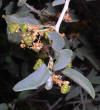
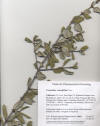
















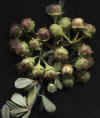









-Ceanothus_cuneatus_small.jpg)
-Ceanothus_cuneatus_small.jpg)
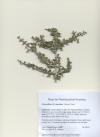




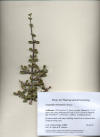





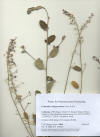





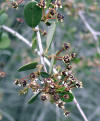
Ceanothus_insularis_small.jpg)
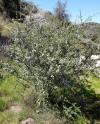

-Ceanothus_oliganthus-_small.jpg)
-Ceanothus_oliganthus-_small.jpg)

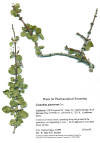
-Ceanothus_ramulosus_small.jpg)
-Ceanothus_cuneatus_small.jpg)



